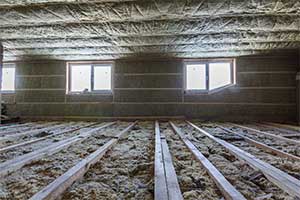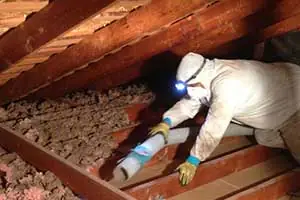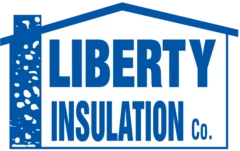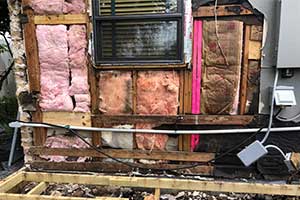Home insulation is a critical but often overlooked part of your home’s energy efficiency and comfort. Pennsylvania families just like you spend an average of more than $2,000 annually on their energy bill, and aging or inadequate installed insulation can drive those costs even higher. Replacing your old insulation at the right time is the best way to improve your comfort and reduce your heating and cooling costs.
Let’s explore some key signs of aging insulation, why it matters, and the best upgrade options, as well as some Pennsylvania-specific factors (like climate and state programs) that can influence when and why you should replace your insulation.
 The Hidden Costs of Aging Insulation
The Hidden Costs of Aging Insulation
Since home insulation is essential for energy efficiency, having outdated or damaged insulation in your home can significantly increase your energy costs. Remember that $2,000 a year we just mentioned? That’s thanks to the unnecessary heat loss from your poor insulation.
Signs You Need New Insulation
High Energy Bills and Constant Thermostat Adjustments
If you’re constantly adjusting your thermostat to stay comfortable and your recent electric bills have not been pretty, your insulation (or lack thereof) may be the culprit. Insulation that lets all the cold air in and the hot air out will force your heating system to work overtime (and vice versa in the summer), leading to excessive energy waste.
Cold Spots and Drafts in Your Home
Do you experience cold spots and drafts from time to time in certain parts of your home? They’re not just a part of your house; they’re a strong indicator that you have air leaks. Drafts and cold spots are a clear message that warm air is escaping in the winter and cold air is leaking out during the summer, creating an uncomfortable home and higher energy costs. Updated wall insulation will add a thermal blanket around your home to help with create and even temperature while air sealing will eliminate the leaks.
 Mold, Moisture, and Insulation Damage
Mold, Moisture, and Insulation Damage
Whether it’s from a heavy rainfall, a leaky pipe or window, or you just have an extra humid home, wet insulation loses its effectiveness and can easily lead to mold and mildew, impacting your indoor air quality. Over time, moisture can deteriorate your insulation and cause long-term structural damage to your home, making your only choice insulation replacement.
Signs of Rodent or Pest Infestations
Mold and mildew are gross, but discovering signs of rodents and pests in your insulation adds another level to the yuck meter. If your attic or walls have signs of pests—such as droppings or chewed insulation—your installed insulation may be compromised. Contaminated insulation can introduce bacteria and allergens into your home, requiring full removal and replacement.
Insulation Lifespan: Knowing When It’s Too Old
Different insulation materials have varying lifespans. Fiberglass can last 80+ years, while loose fill insulation, like cellulose can start to lose its effectiveness within 20-30 years. If your home is older and hasn’t been updated, it may need an insulation upgrade.
Wasted Energy: The Impact of Old Insulation
Your old, ineffective insulation can allow up to 25% of heat loss through your roof and 35% through the walls. That’s bad news for your energy bill! Thankfully, the U.S. EPA estimates that sealing air leaks and upgrading the insulation in your home can save you an average of 15% on your heating and cooling costs.
HVAC Strain and Increased Wear on Your System
You aren’t the only one that suffers when your home has poor insulation. Your HVAC system must work harder to keep your home comfortable, leading to higher maintenance and replacement costs. Surprisingly, studies show that 90% of U.S. homes are under-insulated and aren’t as energy efficient as they could be. That’s a lot of overworked HVAC units.
Vermiculite Insulation: A Health Hazard in Older Homes
Homes built before 1990 may contain vermiculite insulation, a pebble-like type of insulation that could contain asbestos. If found, the EPA highly recommends professional removal by a certified removal company.
Options for Replacing Old Insulation

- Spray foam insulation– Best for air-sealing properties
- Fiberglass batts– Common and cost-effective
- Loose fill insulation– Ideal for hard-to-reach areas
Timing Your Insulation Upgrade for Maximum Benefit
The best time to replace your home’s insulation is during home renovations, when your walls are already exposed, or before peak winter and summer seasons to maximize energy efficiency. If your home has 20-30+ year-old insulation, it should be checked against today’s R-value standards to ensure proper home energy performance.
Pennsylvania’s Climate and Insulation Needs
Here in Pennsylvania, we’re no stranger to cold winters and hot summers. That’s why our homes need high-quality insulation materials for year-round comfort. Since insulation building codes have been updated, homes built before 2000 often do not meet today’s energy efficiency standards. For instance, updated codes require an R-value of R-49 for attic insulation, where an older home may only have R-19 or R-30. Upgrading insulation in your home helps bring it up to today’s standards and saves energy.
State and Federal Incentives for Insulation Upgrades
Be sure to take advantage of local and federal incentives to help you save money while making energy upgrades. You can benefit from state weatherization programs and utility rebates, such as Duquesne Light’s $400 insulation rebate. Also, the federal Energy Efficient Home Improvement Credit offers up to $1,200 in tax credits for insulation upgrades. These incentives make adding insulation more affordable while improving energy efficiency.
Save Energy, Improve Comfort, and Reduce Costs
Replacing your old insulation is a big win for you and your family. You’ll enjoy a well-insulated home that lowers your heating and cooling costs, improves your home’s comfort, and promotes healthier indoor air, as well as reduces energy consumption, and lowers your carbon footprint.
Don’t hesitate to act when you see signs of outdated or damaged insulation. Take advantage of Pennsylvania’s rebate programs and incentives and upgrade the insulation in your home now for long-term energy efficiency. Our expert team at Liberty Insulation provides insulation solutions customized for your home. Contact us today to learn more about how insulation upgrades can benefit your York area home.
References
Energy Smart Home Improvement. “Has Your Insulation Gone Bad? The Signs It’s Time To Replace Insulation.” Energy Smart Home Improvement Blog, 30 Nov. 2023, www.paenergysmart.com/blog/has-your-insulation-gone-bad-signs-its-time-replace-insulation.
Energy Smart (EnergySmart Insulation). “Got Old Insulation In Your NEPA Home? Here’s What to Do.” EnergySmart Insulation Blog, 25 Feb. 2024, nepaenergysmart.com/got-old-insulation-in-your-nepa-home-heres-what-to-do.
HEAT Squad. “How Much Heat Are You Losing?” NeighborWorks of Western Vermont – HEAT Squad Blog, 26 Feb. 2019, www.heatsquad.org/how-much-heat-are-you-losing/.
North American Insulation Manufacturers Association (NAIMA). “About 90% of U.S. homes are under-insulated, NAIMA says.” Pro Builder, 14 Oct. 2015, www.probuilder.com/about-90-us-homes-are-under-insulated-naima-says.
Pennsylvania Department of Community and Economic Development. “Weatherization Assistance Program (WAP).” PA DCED, n.d., dced.pa.gov/programs/weatherization-assistance-program-wap/. Accessed 18 Feb. 2025.
The Editors of Encyclopædia Britannica (E. Willard Miller and Carol L. Thompson). “Pennsylvania – Humid, Temperate, Atlantic (Climate).” Encyclopædia Britannica, 18 Feb. 2025, www.britannica.com/place/Pennsylvania-state/Climate.
Unique Heating & Cooling. “Pennsylvania Energy Efficiency Incentives, Credits, and Rebates.” Unique Heating & Cooling Blog, n.d., www.uniqueheatingandcooling.com/blog/pa-energy-efficiency-rebates. Accessed 18 Feb. 2025.
United States, Environmental Protection Agency. “Methodology for Estimated Energy Savings (Seal and Insulate with ENERGY STAR).” ENERGY STAR, n.d., www.energystar.gov/saveathome/seal_insulate/methodology. Accessed 18 Feb. 2025.
United States, Environmental Protection Agency. “Protect Your Family from Asbestos-Contaminated Vermiculite Insulation.” EPA.gov, updated 14 May 2024, www.epa.gov/asbestos/protect-your-family-asbestos-contaminated-vermiculite-insulation.
Insulation Institute (North American Insulation Manufacturers Association). Pennsylvania Uniform Construction Code: Summary of Key Residential Energy Code Requirements. Insulation Institute, 2024, insulationinstitute.org/wp-content/uploads/2024/07/N109-PA-Energy-Code-0124.pdf.


 Mold, Moisture, and Insulation Damage
Mold, Moisture, and Insulation Damage